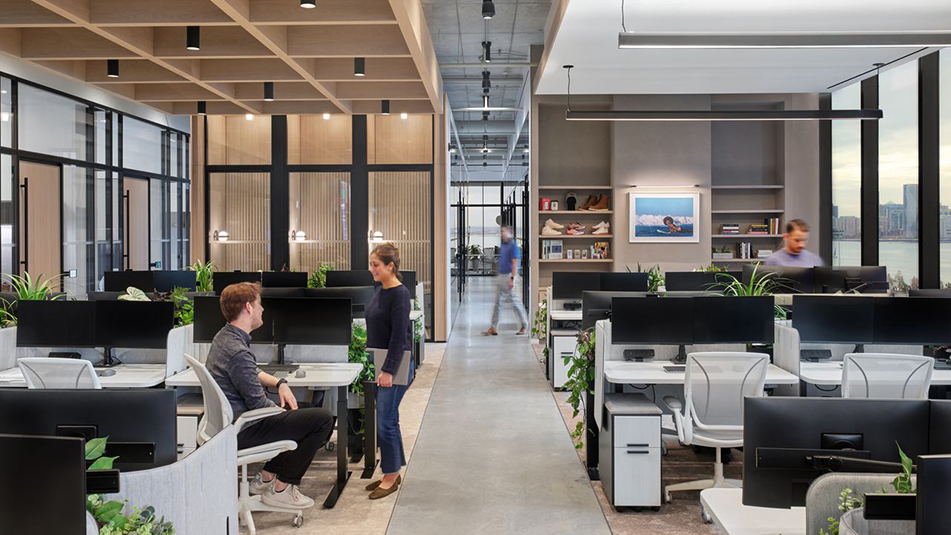Opposition to Opportunity: Fragile Supply Chains
We are living through a uniquely transformational period, with multiple factors contributing to ongoing uncertainty. Occupiers across different supply chains are reacting to negative pressures in different ways, addressing space and labor constraints to reduce cost and risk, but also using these rapidly changing times to seize competitive advantages. A challenging time for sure, but also a unique opportunity to remake your physical footprint to meet the needs of today and the future, while creating fresh value for customers.
While things are changing weekly, monthly, and sometimes even daily, a few megatrends have emerged. The first of those trends that we will be diving into has been the global supply chain disruption.
The Supply Chain is Fragile and Subject to Unpredictable Disruptions

Think back prior to COVID. At the time consumer demand in the US was at the highest level in history. The pandemic disrupted that, causing a dip in spending in the last half of 2020. There, understandably, was a lot of uncertainty in the system. However, it wasn’t long until we returned to the highest spending rates ever in Q1 of 2021. The interesting part about this is that it wasn't the same type of spending. The increase for consumer goods increased exponentially. The money previously spent on travel and entertainment was shifted to consumer goods. The issue of demand was made more complicated by the labor shortage, particularly in the warehouse and transit industries.

In March of 2021, the Evergreen, which for scale is larger than the Eiffel Tower, was blocking the Suez Canal. That one event impacted 10% of our global supply chain. This goes to show you how fragile our systems really are and how important it is to really maintain control of ports and the ability to get the goods where they need to go.
Is it Temporary?
We’re not economists. But we do believe the supply chain could be at risk for some time to come. We are in a more dangerous time than we ever have been. So, we must turn opposition into opportunity, viewing industrial real estate as a vehicle, a way to deliver value to your firms. We all have competitors but, everyone that is trying to deal with industrial space, manufacturing, distribution, land and the labor that works in your facilities, is competing on the same playing field.
The good news is you don’t have to have the perfect solution, you just be a little bit better than the other players in your ecosystem and supply chain.
It’s All About Finding Value
Directors of real estate and the teams that support them are taking immovable, inflexible assets and creating flexibility. We’re seeing occupiers step back. Instead of looking at projects individually, they’re looking at things from a portfolio perspective and getting creative about how to utilize a portfolio wisely to extract value. Managers of industrial space have become experts in resiliency in building value for their organizations.
In the video below, Steven DuBuc, Managing Director, ALIX PARTNERS talks about reactive versus proactive approaches in the supply chain, as well as what you can do inside your facility.
Key Takeaways:
- Qualify second sources, closer to home, with less transportation, tariff exposure
- Map supply chain exposures and reduce them through reshoring, product redesign, etc.
- Build in flexibility to accommodate unpredictable disruptions
What Steven discusses here is about going multiple layers into the bill of material to figure out what risks there are. Before the pandemic, most would have said that the supply chains were tuned up, that all the Ph. D.s, logistics experts and transportation experts had figured out how to make our supply chains hum. But what we’ve learned through all the unpredictable disruptions, is that you have to look further into the bill of material.
Focus on addressing these problems with improved location and inventory strategies. As far as location goes, it doesn’t matter what the math says, you can’t put something where there is no availability and no labor. Inventory strategies include how forward to place finished goods stock. It demands the last mile, but it also demands more regional distribution centers.
Winning in the Current Environment
Firms have broad goals in sustainability and growth that must be paired with the ability to deliver. Be realistic with your stakeholders. Industrial occupiers are at the crossroads of so many challenges.
Economic cycles are curbed by shocks, but there is an ebb and flow to take advantage of. Dispose of space if needed at the top of the market and figure out a way to find markets that are less competitive.
This is the first of a series of blog posts that will dive into each of the megatrends covered at the IAMC Fall Forum by Greg Schementi and Tricia Trester. View the full presentation in the video below and check back as we cover issues in sustainability, labor shortages and construction costs.
Key Takeaways:
- Focus on trust vs transactions
- Recapture leverage from the Market
- Embrace tech selectively
- Reimagine the supply chain
- See real estate through the lens of labor


